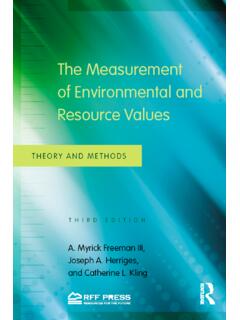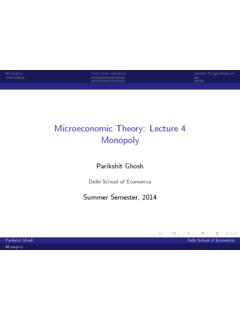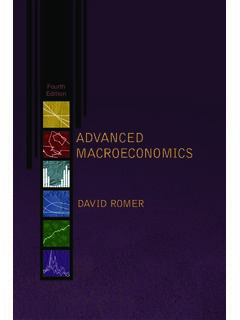Transcription of Natural Resource and Environmental Economics
1 Natural Resource and Environmental EconomicsRoger Perman Yue Ma James McGilvray Michael Common3rd editionNatural Resource and Environmental EconomicsRoger Perman Yue Ma James McGilvray Michael CommonNatural Resource and Environmental EconomicsRoger Perman Yue Ma James McGilvray Michael Common3rd edition3rd editionNatural Resource and Environmental Economicsisamong the leading textbooks in its field. Well written andrigorous in its approach, this third edition follows in the veinof previous editions and continues to provide a compre-hensive and clear account of the application of economicanalysis to Environmental issues.
2 The new edition retains allof the topics from the second edition but has beenreorganised into four Parts: I Foundation II EnvironmentalPollution III Project Appraisal IV Natural text has been written primarily for the specialistmarket of second and third year undergraduate andpostgraduate students of Economics . Roger Permanis Senior Lecturer in Economics ,Strathclyde University. His major research interests andpublications are in the field of applied econometrics andenvironmental Economics . Michael Commonis Professor in the Graduate School ofEnvironmental Studies at Strathclyde University. His majorresearch interests are the development of ecologicaleconomics and policies for sustainability.
3 Yue Mais Associate Professor in Economics , LingnanUniversity, Hong Kong, and Adjunct Professor of LingnanCollege, Zhongshan University, China. His major researchinterests are international banking and finance, as well asenvironmental Economics for developing countries. The late James McGilvraywas Professor of Economics atStrathclyde University. He made important contributions inthe fields of input-output analysis, social accounting andeconomic statistics, and to the study of the Economics oftransition in Central and Eastern Europe. : New chapterson pollution control with imperfect information; cost-benefit analysis and other project appraisal tools; and stock pollution problems Substantial extensionsto existing chapters, including a thorough account of game theory and its application to international Environmental problems; fuller treatments of renewable Resource and forestry Economics .
4 And greater emphasis on spatial aspects of pollution policy New pedagogical featuresincluding learning objectives, chapter summaries, further questions and more concise boxed cases New accompanying websiteat a rich variety of resources for both lecturers and students Case studiesand examplesare used extensively, highlighting the application of theory Further readings, discussion questionsand problemsconclude each chapter Detailed mathematical analysisis covered in appendices to the relevant chapters Writing style andtechnical levelhave been made more accessible and consistentCover Image Getty Natural Resource and Environmental EconomicsThird EditionRoger PermanYue MaJames McGilvrayMichael Common Pearson Education LimitedEdinburgh GateHarlowEssex CM20 2 JEand Associated Companies throughout the worldVisit us on the World Wide Web published 1996 Longman Group LimitedSecond edition 1999 Addison Wesley Longman LimitedThird edition 2003 Pearson Education Limited Longman Group
5 Limited 1996 Addison Wesley Longman Limited 1999 Pearson Education Limited 2003 The rights of Roger Perman, Yue Ma, James McGilvray andMichael Common to be identified as the authors of this workhave been asserted by them in accordance with the Copyright,Designs and Patents Act rights reserved. No part of this publication may be reproduced, stored in a retrieval system, or transmitted in any form or by any means, electronic, mechanical,photocopying, recording or otherwise, without either the prior written permission of thepublisher or a licence permitting restricted copying in the United Kingdom issued by theCopyright Licensing Agency Ltd, 90 Tottenham Court Road.
6 London W1P 0273655590 British Library Cataloguing-in-Publication DataA catalogue record for this book is available from the British LibraryLibrary of Congress Cataloging-in-Publication DataNatural Resource and Environmental Economics / Roger [et al.]. 3rd ed. of: Natural Resource and Environmental Economics / Roger Perman,Yue Ma, James McGilvray. bibliographical references and 0-273-65559-0 (pbk.)1. Environmental Economics . 2. Natural resources Sustainable development. I. Perman, Roger, 1949 Natural Resource and Environmental P446 dc2120020425671098765432106 05 04 03 Typeset in Times by 35 Printed and bound by Ashford Colour Press Ltd.
7 , Gosport ContentsPreface to the third EditionxiiiAcknowledgementsxvNotationxvi IntroductionxixPart IFoundationsChapter 1An introduction to Natural Resource and Environmental economics3 Learning emergence of Resource and Environmental issues in the economic approach to Resource and Environmental s guide12 Summary14 Further reading15 Chapter 2 The origins of the sustainability problem16 Learning environment drivers of Environmental and to growth? pursuit of sustainable development48 Summary52 Further reading52 Discussion questions54 Problems54 Chapter 3 Ethics, Economics and the environment56 Learning objectives56 Introduction56 moral moral of distribution67 Summary75 Further reading75 Discussion questions76 Problems77 Appendix The Lagrange multiplier method of solving constrained optimisation problems77 Appendix Social welfare maximisation80 Chapter 4 Concepts of sustainability82 Learning and on on institutional and policy97 Summary103 Further reading103 Discussion questions104 Problems104 Chapter 5 Welfare Economics and the environment105 Learning objectives105 Introduction105 Part IEfficiency and efficient allocation of resources is not social
8 Welfare function and tests113 Part IIAllocation in a market given ideal equilibrium analysis of market allocations are not necessarily equitable122 Part IIIM arket failure, public policy and the existence of markets for Environmental second-best failure144 Summary145 Further reading146 Discussion questions146 Problems146 Appendix Conditions for efficiency and optimality147 ContentsviiAppendix Market outcomes152 Appendix Market failure153 Part IIEnvironmental pollutionChapter 6 Pollution control: targets165 Learning pollution flows, pollution stocks, and pollution efficient level of static model of efficient flow efficiency levels of emissions of stock control where damages depend on location of the pollution analysis of stock and non-convexity in damage and abatement cost the costs of abating pollution targets on grounds other than economic efficiency193 Summary194 Further reading195 Discussion questions196 Problems196 Appendix Matrix algebra196 Appendix Spatially differentiated stock pollution: a numerical example201 Chapter 7 Pollution control.
9 Instruments202 Learning for choice of pollution control efficiency and cost-effective pollution abatement for achieving pollution abatement incentive (quasi-market) control where damages depend on location of the comparison of the relative advantages of command and control, emissions tax, emission abatement subsidy and marketable permit instruments234 Summary238 Further reading239 Discussion questions240 viiiContentsProblems241 Appendix The least-cost theorem and pollution control instruments242 Chapter 8 Pollution policy with imperfect information247 Learning in identifying pollution targets in the context of limited information and approaches to target setting and the precautionary relative merits of pollution control instruments under conditions of costs and Environmental regulation261 Summary266 Further reading267 Discussion question268 Problems268 Chapter 9 Economy-wide modelling269
10 Learning output input output and general equilibrium models281 Summary290 Further reading290 Discussion questions290 Problems291 Appendix A general framework for Environmental input output analysis291 Appendix The algebra of the two-sector CGE model295 Chapter 10 International Environmental problems297 Learning Environmental theory contributing to enhancing probability of international agreements or achieving a higher degree of treaties: rain ozone greenhouse trade and the environment339 Learning outcomes342 Further reading343 Discussion questions345 ContentsixProblems346 Appendix Some algebra of international treaties346 Part IIIP roject appraisalChapter 11 Cost benefit analysis351 Learning welfare benefit analysis and the environment373 Summary385 Further reading386 Discussion questions387 Problems387 Appendix Conditions for intertemporal efficiency and optimality388 Appendix Markets and intertemporal allocation395 Chapter 12 Valuing the environment399 Learning of theory of Environmental valuation travel cost




